By Tracee
There are a lot of reasons not to grow your own food, ranging from “I don’t have time” to “I don’t like to get dirty.” I think all of the reasons can be distilled into two primary reasons: 1) it’s a lot of work, and 2) it’s far easier to go to the grocery store.
For Matt and I, our reasons for gardening outweigh the reasons not to. Matt and I enjoy that sort of work, and believe in gardening methods that will reduce the amount of work it takes to garden. And since I was diagnosed with Hashimoto’s disease in 2014, and with our son having allergies, we have taken a hard look at our food supply as a way to improve our health. My strategy for reversing Hashimoto’s is two-fold: eliminate toxins and processed foods that viruses thrive on, and strengthen my body with nutrient-rich, clean healing foods to make my body strong enough to kill viruses by itself. It doesn’t work overnight, but it is definitely working. This means that when we go to the grocery store, we buy less processed foods and much, much more produce. Looking at our grocery cart, a natural question for us was: why are we coming here to buy this?
This was the first year for our garden on our homestead, and I’d like to share what our goals were, what we had to work with, some challenges we faced, some methods we used and some lessons learned.
We chose a very small section of our 27 acre lot that receives great southern light. It was once farmed for corn. Monoculture or monocropping is planting one crop in a field year after year in order to systematize food production. One of the consequences of monocropping is that it extracts the nutrients out of the soil leaving it weak and unable to support another crop without adding chemical fertilizers. Monocropping also produces pests and diseases that require chemical pesticides. These chemicals are in our food supply, deplete the soil and degrade the quality of our planet.
We learned from records that the last crop planted in our field was corn in 2014, so the earth had a 2+ year break from chemicals (in an agricultural setting, the half-life of pesticides can range from a few hours to 4-5 years), and the soil was weak. Our soil test revealed that it was weak in nitrogen and phosphorus, and in the mid-range for potassium. Weeds had overtaken the field, we didn’t have a water supply and we knew deer and rabbits would be interested in what we were planting.
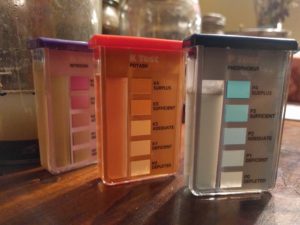
Our primary goal with our garden was simply to establish it, knowing that this was going to be the hardest year. In addition to using organic farming methods, we wanted to employ permaculture principles and techniques such as no-dig gardening, planting diverse plant species, sheet mulching, using hugelkultur and swales so that in subsequent years, the garden becomes more of a stewardship task and less one of labor.
We started with making a hugelkultur. Hugelkultur are no-dig raised beds that hold moisture and build fertility within the organic layers beneath it. Matt dug a long hole, we placed branches and logs at the bottom, sticks next and then finer organic matter on top of that. We topped it off with soil, mounding it.
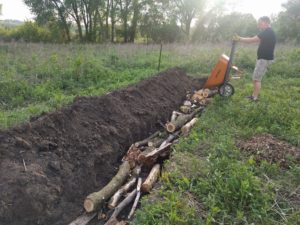
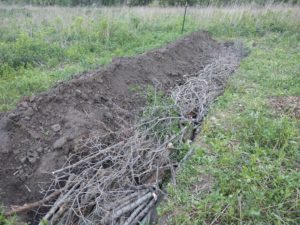

As the layers of logs, branches, sticks and organic matter start to decay (in a few years), it will act like a sponge holding moisture for plants above, and as it decays it will slowly release essential nutrients and minerals to the plants above and warm the soil. We placed it perpendicular to the slope so that rain runoff would collect at the mound (this is the spirit of building a swale although swale design is much more specific to catching rainwater in trench areas above/on the ground).
We successfully grew pole beans, strawberries, Tundra Honeyberries, and some red onions on the hugelkultur. We had a much harder time growing carrots, lettuce and kale on the mound, but that was mostly thanks to the rabbits.
The rabbits. Sigh. One day, Matt asked me “Honey, didn’t we used to have four blueberry plants?” This pretty much sums up the situation we were dealing with. They were eating everything, including the tomato plants we set into bales (that was pretty much the end of that experiment). Surprisingly, they also ate an entire ghost pepper plant. We weren’t confident that our efforts weren’t being wasted.
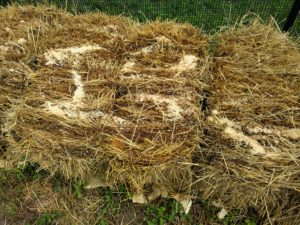
The fence we had around our garden was a mesh fence that we had used the previous year in the community garden. We staked the lower edge into the ground, but the rabbits just ate holes through it. Clearly we needed a better fence (more on that later). An $18 fake owl renewed our confidence in proceeding.
We planted both perennials and annuals. Perennials included strawberries, hops, honeyberry, blueberries, comfrey and an apple tree. Annuals included potatoes, cucumbers, zucchini, watermelon, onions, and beans. We used sheet mulching extensively, mostly for weed control this year, even though it’s very well suited for nurturing the soil and as a no-dig gardening technique. This was a critical technique for us to use since the landscape was formerly weeds that grew taller than us. It helped us keep the situation under control without losing our minds. I think I weeded twice the whole summer.
We planted a lot of other things that didn’t make it due to the rabbits (lettuce, cabbage, carrots, etc) but we tried again late in the summer with success.
Lessons Learned
The biggest lesson we learned was that we needed a serious fence. Without the owl, we would have lost most of the garden and had to stop, so major kudos to the owl. But the mesh fence needs to be replaced and we figure we’d do a permanent one. So we went to my mom’s place to cut down some of her Black Locust trees that she wanted out; they make ideal posts because they grow very straight and don’t rot when put in the ground. We got 27 eight-foot posts and started building a new fence for next year, which we will finish in the spring.
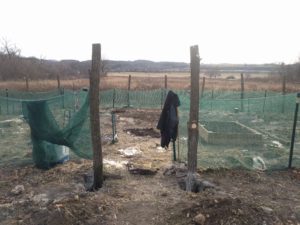
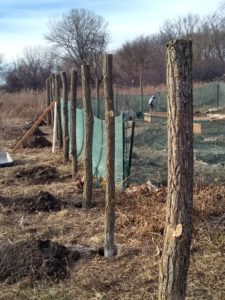
Second lesson: sheet mulching is fantastic! I think if we had not done it, we would have been frustrated quickly and lost motivation; the surrounding weeds would have gotten the best of us. But as it turned out, the sheet mulching gave us leverage to establish the garden. I look forward to augmenting the technique with compost tea, comfrey tea and other natural fertilization techniques for more robust and hardy plants and soil.
Lastly, we know that by planting certain plants next to each other, they help each other grow (companion planting) but we didn’t practice this very much because we were more concerned with losing plants to rabbits and weeds. And we weren’t able to grow the kind of diversity of plants we were hoping to. But now that the basics are in place, we’ve very excited to implement more of the techniques that will help our garden (and us) thrive in the long run!
Even with the challenges and setbacks, our first year garden was successful and we are looking forward to building on what we established next summer! Late in the summer, we added two large raised beds and planted garlic, so we’ve already started next summer’s garden!
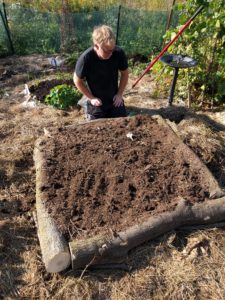
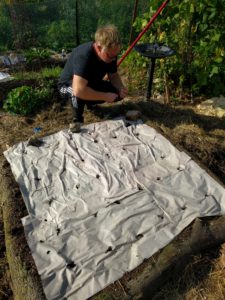
I like the idea of sheet mulching. Where did you buy yours?
We had lots of wrapping paper from our move from New York to Rochester, its basically newspaper without any print, although its a bit more slippery.